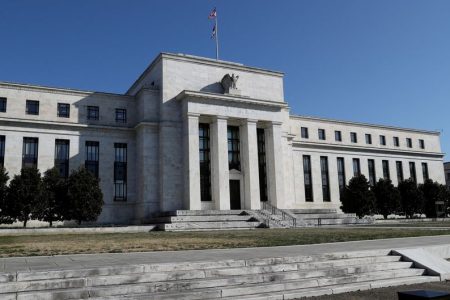By Lindsay Dunsmuir
(Reuters) -There was an uptick in U.S. economic activity from early January through late February while inflation and the jobs market presented conflicting signals on how quickly they will cool further, a U.S. Federal Reserve survey showed on Wednesday, underscoring the complicated picture for central bankers as they seek to fully tame pricing pressures.
The U.S. central bank released its latest temperature check on the health of the economy after Fed Chair Jerome Powell said earlier on Wednesday that it remains unclear when the Fed may cut interest rates and underpin the current expansion given further progress on inflation was not assured.
Powell and his colleagues are attempting to engineer a so-called “soft landing” for the economy in which economic growth gradually slows and the unemployment rate remains low even as inflation, which spiked to a 40-year high two years ago, returns to the Fed’s 2% target rate.
“Economic activity increased slightly, on balance,” the Fed said in its survey released on Wednesday, known as the “Beige Book,” which polled business contacts across the central bank’s 12 districts through Feb. 26. “The outlook for future economic growth remained generally positive, with contacts noting expectations for stronger demand and less restrictive financial conditions over the next 6 to 12 months.”
Eleven of the 12 Fed regions reported steady or increased economic activity with the other district noting a slight softening.
Since March 2022, the central bank has raised its policy rate by 525 basis points to the current 5.25%-5.50% range, where it has been held since July. While rates are set to remain unchanged at the next interest-rate setting meeting on March 19-20, Fed officials in December provisionally penciled in three rate cuts this year.
PERSISTING INFLATION
Recent stronger-than expected data on employment and inflation though has raised fears that the economy is still too robust for pricing pressures to fully return to the Fed’s target rate. By the Fed’s preferred measure, inflation in January was running at a 2.4% annual rate, down from the 7.1% peak reached in June 2022.
The Fed’s survey did little to provide clarity. While contacts said the labor market had eased further in recent weeks, wages also grew although several Fed districts indicated a slower pace of gains.
For example, the Kansas City Fed described pay for new hires as “elevated,” but said many contacts were focusing wage increases “primarily on workers who expanded their capabilities, responsibilities, and productivity.”
On inflation, Fed contacts reported businesses finding it harder to pass through higher costs to their customers. There were, however, also renewed upward pressures with contacts citing increases in freight costs and several insurance categories, including employer-sponsored health insurance.
Elsewhere, the report highlighted the ongoing drag from inflation, even as several districts reported price pressures moderating. “I wish my twenty-dollar [sandwich] lunch went back to [costing] ten,” a Minnesota worker told the Minneapolis Fed. “It instead keeps going up.”
(Reporting by Lindsay Dunsmuir, Ann Saphir and Dan Burns; Editing by Andrea Ricci)

